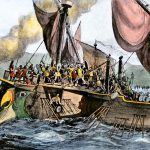This very interesting piece of legislation took place in 1871, some six years after the end of the American Civil War (1861-65). It was attended by the Canadian Prime Minister J.A. Macdonald as well as delegates from the United States and Great Britain. Perhaps Macdonald was there to keep an eye on the proceedings, because the United States wanted compensation from Britain because she had sold arms to the Confederate side during the Civil War.
The Confederate Army consisted of ‘raiders’, said the indignant Unionists, and had inflicted much damage. It was pointed out that the Union Army hadn’t done badly either, inflicting perhaps more damage during the confrontation than had the Confederates. The Canadian PM was there, he said, because he wanted some arbitration of the boundary south of Vancouver Island. He also wanted possession of the strategically important island of San Juan. Canada was willing to concede rights to US fishermen to come and fish in her territorial waters. There were therefore hopes of a trade agreement.
Mr Macdonald, being no fool, knew perfectly well that Britain was anxious to re-establish friendly relations with the States, and would certainly pussyfoot around the issues while she got ready to dig deep into her capacious purse to pay the Union. He wanted to make sure Canada did not get a raw deal while this was happening.
Inevitably, the US secured compensation, though it is intriguing to learn that Britain had sold arms and supplies to both sides. By then the defeated Confederates could not have raised the cash needed to buy a train ticket to the Conference, so this piece of double dealing and hedging your bets was not discussed, officially anyway. Canada ensured a favourable settlement of the boundary question and also got free navigation of Alaska’s rivers, which was crucial for the Hudson’s Bay Company. In exchange, the US could freely use the St. Laurence river.
Macdonald capped it all by negotiating fishing and trade agreements between Canada and the US which were the foundation for an arrangement mutually to consult each other before any international crises involving Great Britain could start. Thus Canada got what she wanted; the United States could dry her offended tears, and Britain paid up. Queen Victoria was said not to be amused, but she could blame her Prime Minister Mr Gladstone, whom she disliked. Most American lips could be seen to tremble a bit. Mr Macdonald achieved a great deal. Everything could be said to have been quite dandy.










Leave A Comment